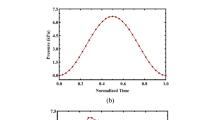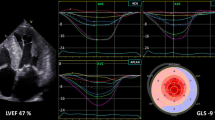Abstract
Aortic stiffness is an important risk factor for cardiovascular events and morbidity. Increased aortic stiffness is associated with an increase in cardiac and vascular hypertension-related organ damage. To evaluate the biomechanical properties of the ascending aorta (AA) in patients with arterial hypertension (AH) by velocity vector imaging (VVI). Ninety-five patients with AH and 53 normal healthy control participants were prospectively enrolled. AA biomechanical properties, i.e., ascending aortic global longitudinal strain (ALS), ascending aortic global circumferential strain (ACS), and fractional area change (FAC), were evaluated by VVI. Relative wall thickness (RWT) and left ventricular mass (LVM) were calculated. Pulsed Doppler early transmitral peak flow velocity (E), early diastolic mitral annular velocity (e′), left ventricular global longitudinal strain (GLS), distensibility (D) and stiffness index (SI) of AA were also obtained. The ALS, ACS and FAC were significantly lower in the AH patients, especially in those with ascending aorta dilatation (AAD), than in the normal healthy control subjects. The patients with AAD had a higher E/e′ ratio, RWT, LVM and SI and a lower GLS and D than patients without AAD and normal healthy volunteers (p < 0.05). There were significant associations between biomechanical properties and D, SI, E/e′ and GLS (ALS and D: r = 0.606, ALS and SI: r = − 0.645, ALS and E/e′: r = − 0.489, ALS and GLS: r = 0.466, ACS and D: r = 0.564, ACS and SI: r = − 0.567, ACS and E/e′: r = − 0.313, ACS and GLS: r = 0.320, FAC and D: r = 0.649, FAC and SI: r = − 0.601, FAC and E/e′: r = − 0.504, FAC and GLS: r = 0.524, respectively, p < 0.05). The biomechanical properties of AA were impaired in patients with AH, especially patients with ascending aorta dilatation. Hypertension is associated with a high prevalence of diastolic and systolic dysfunction and increased arterial stiffness. Further study is needed to evaluate the clinical application of AA biomechanical properties by VVI.




Similar content being viewed by others
Abbreviations
- AA:
-
Ascending aorta
- AH:
-
Arterial hypertension
- VVI:
-
Velocity vector imaging
- ALS:
-
Ascending aortic global longitudinal strain
- ACS:
-
Ascending aortic global circumferential strain
- FAC:
-
Fractional area change
- PP:
-
Pulse pressure
- E:
-
Pulsed Doppler early transmitral peak flow velocity
- e′:
-
Early diastolic mitral annular velocity
- D:
-
Distensibility
- SI:
-
Stiffness index
- SBP:
-
Systolic blood pressure
- DBP:
-
Diastolic blood pressure
- LAD:
-
Left atrial diameter
- LVEDD:
-
LV end-diastolic diameter
- RWT:
-
Relative wall thickness
- LVM:
-
Left ventricular mass
- HR:
-
Heart rate
- EF:
-
Ejection fraction
- SOV:
-
Sinus of valsalva
- ASCs:
-
Ascending aorta
- GLS:
-
The global longitudinal strain
References
Milan A, Degli Esposti D, Salvetti M, Izzo R, Moreo A, Pucci G, Bruno G, Pareo I, Parini A, Paini A, Laurino FI, Sormani P, Sgariglia R, Avenatti E, De Luca N, Working Group on Heart and Hypertension of the Italian Society of Hypertension (2019) Prevalence of proximal ascending aorta and target organ damage in hypertensive patients: the multicentric ARGO-SIIA project (Aortic remodeling in hypertension of the Italian society of hypertension). J Hypertens 37:57–64
Mattace-Raso FU, van der Cammen TJ, Hofman A (2006) Arterial stiffness and risk of coronary heart disease and stroke: the Rotterdam study. Circulation 113:657e63
Kearney PM, Whelton M, Reynolds K, Muntner P, Whelton PK, He J (2005) Global burden of hypertension: analysis of worldwide data. Lancet 365:217–223
Mitchell GF (2018) Aortic stiffness, pressure and flow pulsatility, and target organ damage. J Appl Physiol 125:1871–1880
Laurent S, Alivon M, Beaussier H, Boutouyrie P (2012) Aortic stiffness as a tissue biomarker for predicting future cardiovascular events in asymptomatic hypertensive subjects. Ann Med 44:S93–S97
Mancia G, Fagard R, Narkiewicz K, Redon J, Zanchetti A, Böhm M, Christiaens T, Cifkova R, De Backer G, Dominiczak A, Galderisi M, Grobbee DE, Jaarsma T, Kirchhof P, Kjeldsen SE, Laurent S, Manolis AJ, Nilsson PM, Ruilope LM, Schmieder RE, Sirnes PA, Sleight P, Viigimaa M, Waeber B, Zannad F, Redon J, Dominiczak A, Narkiewicz K, Nilsson PM, Burnier M, Viigimaa M, Ambrosioni E, Caufield M, Coca A, Olsen MH, Schmieder RE, Tsioufis C, van de Borne P, Zamorano JL, Achenbach S, Baumgartner H, Bax JJ, Bueno H, Dean V, Deaton C, Erol C, Fagard R, Ferrari R, Hasdai D, Hoes AW, Kirchhof P, Knuuti J, Kolh P, Lancellotti P, Linhart A, Nihoyannopoulos P, Piepoli MF, Ponikowski P, Sirnes PA, Tamargo JL, Tendera M, Torbicki A, Wijns W, Windecker S, Clement DL, Coca A, Gillebert TC, Tendera M, Rosei EA, Ambrosioni E, Anker SD, Bauersachs J, Hitij JB, Caulfield M, De Buyzere M, De Geest S, Derumeaux GA, Erdine S, Farsang C, Funck-Brentano C, Gerc V, Germano G, Gielen S, Haller H, Hoes AW, Jordan J, Kahan T, Komajda M, Lovic D, Mahrholdt H, Olsen MH, Ostergren J, Parati G, Perk J, Polonia J, Popescu BA, Reiner Z, Rydén L, Sirenko Y, Stanton A, Struijker-Boudier H, Tsioufis C, van de Borne P, Vlachopoulos C, Volpe M, Wood DA (2013) 2013 ESH/ESC guidelines for the management of arterial Hypertension: the task force for the management of arterial hypertension of the European Society of Hypertension (ESH) and of the European Society of Cardiology (ESC). Eur Heart J 34:2159–2219
Bell V, Mitchell WA, Sigurðsson S, Westenberg JJ, Gotal JD, Torjesen AA et al (2014) Longitudinal and circumferential strain of the proximal aorta. J Am Heart Assoc 3:e001536
Guala A, Teixidó-Tura G, Rodríguez-Palomares J, Ruiz-Muñoz A, Dux-Santoy L, Villalva N et al (2019) Proximal aorta longitudinal strain predicts aortic root dilation rate and aortic events in marfan syndrome. Eur Heart J 40:2047–2055
Bjallmark A, Lind B, Peolsson M, Shahgaldi K, Brodin LA et al (2010) (2010) Ultrasonographic strain imaging is superior to conventional noninvasive measures of vascular stiffness in the detection of age-dependent differences in the mechanical properties of the common carotid artery. Eur J Echocardiogr 11:630–636
Kim KH, Park JC, Yoon HJ, Yoon NS, Hong YJ, Park HW et al (2009) Usefulness of aortic strain analysis by velocity vector imaging as a new echocardiographic measure of arterial stiffness. J Am Soc Echocardiogr 22:1382–1388
An HS, Baek JS, Kim GB, Lee YA, Song MK, Kwon BS et al (2017) Impaired vascular function of the aorta in adolescents with turner syndrome. Pediatr Cardiol 38:20–26
Gao J, Lee J, Phan A, Fowlkes JB (2021) Velocity vector imaging to assess longitudinal wall motion of adult carotid arteries. J Ultrasound Med 40:1195–1207
Mancia G, De Backer G, Dominiczak A (2007) Guidelines for the management of arterial hypertension: the task force for the management of arterial hypertension of the European Society of Hypertension (ESH) and of the European Society of Cardiology (ESC). J Hypertens 25:1105–1187
Mancia G, Laurent S, Agabiti-Rosei E, Ambrosioni E, Burnier M, Caulfield MJ et al (2009) Reappraisal of European guidelines on hypertension management: a European society of hypertension task force document. J Hypertens 27:2121–2158
Lang RM, Bierig M, Devereux RB et al (2006) Recommendations for chamber quantification. Eur J Echocardiogr 7:79–108
Nistri S, Grande-Allen J, Noale M (2008) Aortic elasticity and size in bicuspid aortic valve syndrome. Eur Heart J 29:472–479
You BA, Shen L, Li JF, Chen YG, Gu XH, Gao HQ (2012) The correlation between carotid-femoral pulse wave velocity and composition of the aortic media in CAD patients with or without hypertension. Swiss Med Wkly 142:w13546
Zhang Y, Lacolley P, Protogerou AD, Safar ME (2020) Arterial stiffness in hypertension and function of large arteries. Am J Hypertens 33:291–296
Korneva A, Humphrey JD (2019) Maladaptive aortic remodeling in hypertension associates with dysfunctional smooth muscle contractility. Am J Physiol Heart Circ Physiol 316:H265–H278
Wang L, Wang J, Xie M, Wang X, Lv Q, Chen M et al (2009) Clinical study of the ascending aorta wall motion by velocity vector imaging in patients with primary hypertension. J Huazhong Univ Sci Technol Med Sci 29:127–130
Ahmed MK, El-Shafey WE, Adam KF (2019) Assessment of aortic root mechanics in hypertensive patients by speckle tracking echocardiography. World J Cardiovasc Dis 09:212–222
Wu J, Pei Y, Wang Y, Ji J, Gong M, Gu W et al (2022) Evaluation of ascending aortic longitudinal strain via two-dimensional speckle tracking echocardiography in hypertensive patients complicated by type A aortic dissection. J Ultrasound Med 41:925–933
Teixeira R, Monteiro R, Baptista R, Pereira T, Ribeiro MA, Gonçalves A et al (2017) Aortic arch mechanics measured with two-dimensional speckle tracking echocardiography. J Hypertens 35:1402–1410
Song XT, Fan L, Yan ZN, Rui YF (2021) Echocardiographic evaluation of the elasticity of the ascending aorta in patients with essential hypertension. J Clin Ultrasound 49:351–357
Nabati M, Namazi S, Yazdani J (2021) Aortic wall elasticity and left ventricular function in hypertensive patients with nonsignificant coronary artery disease. Ultrasound 29:162–171
Vitarelli A, Giordano M, Germanò G, Pergolini M, Cicconetti P, Tomei F et al (2010) Assessment of ascending aorta wall stiffness in hypertensive patients by tissue doppler imaging and strain doppler echocardiography. Heart 96:1469–1474
Kim SA, Lee KH, Won HY, Park S, Chung JH, Jang Y et al (2013) Quantitative assessment of aortic elasticity with aging using velocity-vector imaging and its histologic correlation. Arterioscler Thromb Vasc Biol 33:1306–1312
Etrini J, Eriksson MJ, Caidahl K, Larsson M (2018) Circumferential strain by velocity vector imaging and speckle-tracking echocardiography: validation against sonomicrometry in an aortic phantom. Clin Physiol Funct Imaging 38:269–277
Longobardo L, Carerj ML, Pizzino G, Bitto A, Piccione MC, Zucco M et al (2018) Impairment of elastic properties of the aorta in bicuspid aortic valve: relationship between biomolecular and aortic strain patterns. Eur Heart J Cardiovasc Imaging 19:879–887
Bell V, Sigurdsson S, Westenberg JJ, Gotal JD, Torjesen AA, Aspelund T, Launer LJ, Harris TB, Gudnason V, de Roos A, Mitchell GF (2015) Relations between aortic stiffness and left ventricular structure and function in older participants in the age, gene/environment susceptibility–Reykjavik study. Circ Cardiovasc Imaging 8(4):e003039
Acknowledgements
We thank all the patients and control subjects for their participation in this study.
Funding
This work was supported by the State Natural Sciences Foundation of China (Nos. 81871372 and 81801721) and the Natural Science Foundation of Hunan Province (Nos. 2019JJ40425 and 2019JJ50880).
Author information
Authors and Affiliations
Contributions
GQ, X and ZR, Y collected general clinical data of the patients and measured blood pressure. SZ and LY consulted the relevant literature. LY performed ultrasound ex-amination and analyzed the patient data. LY was the main contributor to the manuscripts. All authors reviewed the manuscript.
Corresponding author
Ethics declarations
Competing interests
The authors declare no competing interests.
Additional information
Publisher’s Note
Springer Nature remains neutral with regard to jurisdictional claims in published maps and institutional affiliations.
Supplementary Information
Below is the link to the electronic supplementary material.
10554_2023_3003_MOESM1_ESM.jpg
In figure A, the velocity vector image of the traced ascending aorta is shown in the parasternal long-axis view. In figure B, green and white represent the anterior wall of the ascending aorta, and blue and yellow represent the posterior wall of the ascending aorta. In figure C, the velocity vector image of the traced ascending aorta is shown in the great artery short-axis view. In figure D, green represents the anterior wall of the ascending aorta, white represents the left lateral wall of the ascending aorta, blue represents the posterior wall of the ascending aorta, and purple represents the right lateral wall of the ascending aorta. Supplementary material 1 (JPG 8124.7 kb)
Rights and permissions
Springer Nature or its licensor (e.g. a society or other partner) holds exclusive rights to this article under a publishing agreement with the author(s) or other rightsholder(s); author self-archiving of the accepted manuscript version of this article is solely governed by the terms of such publishing agreement and applicable law.
About this article
Cite this article
Yu, L., Xu, G., Zhou, Q. et al. Biomechanical properties of the ascending aorta in patients with arterial hypertension by velocity vector imaging. Int J Cardiovasc Imaging 40, 397–405 (2024). https://doi.org/10.1007/s10554-023-03003-9
Received:
Accepted:
Published:
Issue Date:
DOI: https://doi.org/10.1007/s10554-023-03003-9




